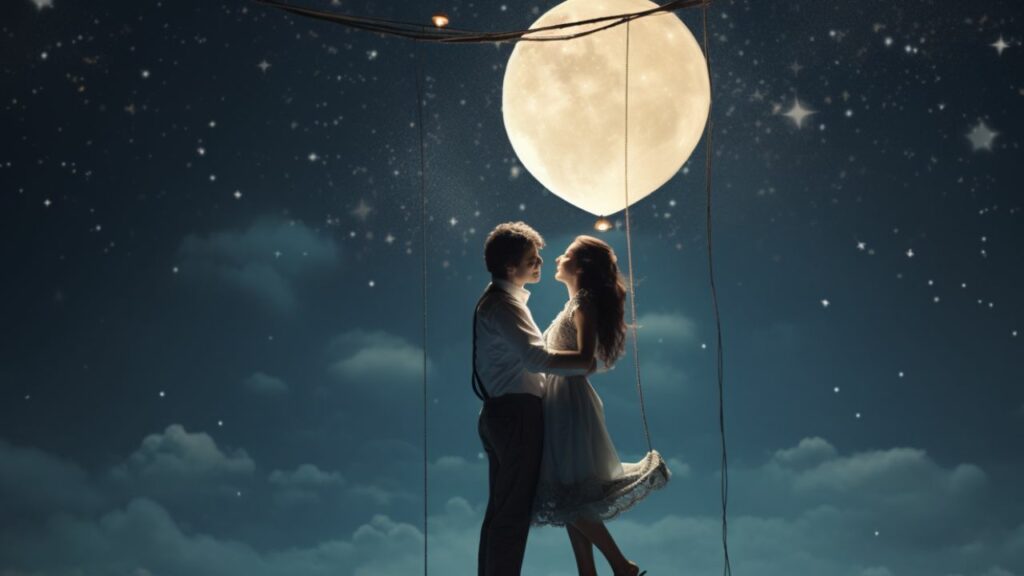We’ve all felt it, that dizzying sensation of falling head over heels for someone. But what exactly is happening in our brains when we tumble into the abyss of love? As an expert in human emotions and relationships, I’d like to delve into the stages of love, exploring each phase from a psychological perspective.
In its infancy, love is a whirlwind of attraction and infatuation. You’re consumed by thoughts of your beloved, with every detail about them seeming absolutely perfect. This honeymoon phase can be intoxicating but it’s also temporary – a fact many people find hard to accept.
Beyond this initial enchantment lies the second stage: deep attachment. Here, comfort and companionship overrule passion as you settle into the rhythm of life together. But don’t be fooled! This isn’t a downgrade from those earlier fireworks; it’s a deeper bond formed through shared experiences and understanding. It may not be as flashy as infatuation but it’s arguably more rewarding.
So why does this transition happen? And how can we navigate these stages effectively? Let’s dive in further, examining the science behind these shifts in emotion and offering some tips on sustaining long-term love.
Understanding the Stages of Love
Ever wonder why love feels like a roller coaster ride? It’s because it doesn’t stand still. It evolves, changes and grows through various stages. Let’s unravel this mystery together.
The first stage is the “Infatuation Stage”. We’ve all been there, haven’t we? When our heart skips a beat every time that special someone comes into view. Butterflies in the stomach become a daily phenomenon. Infatuation can feel exhilarating, but it’s often short-lived.
Next up is the “Honeymoon Phase”. This is when you can’t seem to get enough of each other. You’re both head over heels in love, spending every possible moment together. Studies show that this phase usually lasts from one to two years.
- Stage 1: Infatuation
- Stage 2: Honeymoon Phase
Once the honeymoon phase fades away, reality sets in and we enter the “Disillusionment Stage”. This is when couples start noticing each other’s flaws and arguments may become more frequent.
After weathering through disillusionment (if you make it), you’ll find yourself in the “Deep Attachment Stage”. By now, you’ve seen your partner at their best and worst yet choose to stick with them anyway. This stage signifies deep emotional attachment and stability.
Finally, we have what experts call “Mature Love” or lifelong partnership where companionship trumps passion. The bond forged over shared experiences becomes unbreakable here.
Here are these stages again:
- Stage 3: Disillusionment
- Stage 4: Deep Attachment
- Stage 5: Mature Love
Understanding these stages can help navigate relationships better while also managing expectations realistically.
The First Stage: Attraction and Romance
I’m sure we’ve all felt it, that initial spark when you meet someone who piques your interest. It’s the first stage of love, often characterized by physical attraction and a sense of excitement. This is the time when our hearts race, our palms sweat, and we can’t stop thinking about that special someone.
What causes this overwhelming feeling of attraction? Science suggests it’s a cocktail of chemicals racing through our brains. There’s dopamine, responsible for feelings of happiness and desire; adrenaline which fuels those nervous butterflies; and serotonin that keeps us dreaming about our new love interest.
Let me paint a picture with some examples. Remember that high school crush? The one who made your heart flutter every time they passed by your locker? Or maybe it was a friend who slowly transformed into something more in your eyes. This phase is marked by idealization – seeing only the best in the other person – and intense emotions.
| Chemical | Effect |
|---|---|
| Dopamine | Happiness, Desire |
| Adrenaline | Nervous Excitement |
| Serotonin | Obsessive Thoughts |
But remember folks, while these feelings might be intoxicating at first, they’re not designed to last forever. Psychologist Dorothy Tennov coined the term ‘limerence’ to describe this state. Limerence lasts on average between 18 months to 3 years before transitioning into deeper stages of love.
So let’s break it down:
- Physical attraction kicks things off.
- Brain chemicals like dopamine create happy, obsessive thoughts.
- These intense feelings don’t last forever but transition into deeper stages over time.
Although this stage can feel like a whirlwind, it sets up an important foundation for relationship building as we move forward through subsequent stages of love!
The Second Stage: Building a Deeper Connection
If you’ve ever been in love, you’ll know it’s not all rainbows and butterflies. It’s during the second stage of love that we really start to build those deeper connections. Let me tell you, it’s more than just sharing your favorite pizza toppings or TV shows.
During this phase, trust begins to solidify as the foundation of the relationship. You’re starting to reveal your authentic selves, not just the polished versions you presented during the initial attraction stage. Sharing vulnerable moments and stories is typical during this period. For example, you might discuss past relationships or personal insecurities – yes, we’ve all got them!
Now don’t get me wrong; this stage isn’t always easy. It can be uncomfortable getting so emotionally raw with another person. But studies have shown that vulnerability is key in building deep relationships! According to a study by Dr.Brene Brown at the University of Houston:
| Statistics | |
|---|---|
| 1 | People who were able to form strong bonds reported feeling comfortable being vulnerable with their partner |
It’s also important to note that communication plays a vital role here too – and I’m not just talking about chatting over dinner! Real communication means expressing needs, desires, fears…the whole shebang.
Here are some pointers for effective communication in this stage:
- Be clear about what you need from your partner.
- Show empathy when they share their feelings.
- Respect boundaries set by each other.
At its core though, building a deeper connection boils down to one thing: understanding one another on an intimate level – physically and emotionally. That’s where real love starts taking root!
So there you have it – that’s the second stage of love for ya! While it may feel like an emotional rollercoaster ride at times (and believe me, it often does), remember that it’s paving way for a stronger bond between you and your partner. But hold on tight, we’re just getting started!
The Third Stage: Disillusionment or Understanding?
I’ve arrived at the third stage of love, and let’s be honest – it’s a bit of a crossroad. We all start off in relationships with hearts full of hope, but then reality sets in. This stage can either lead to disillusionment or understanding. It all depends on how we navigate the twists and turns.
Think back to your first love, when everything seemed perfect. Then suddenly you started noticing flaws in your partner that you’d never seen before. You may have even started questioning if you were right for each other at all. That’s disillusionment setting in, folks! But hold on – don’t hit the panic button just yet.
You see, this stage isn’t necessarily a death sentence for your relationship. In fact, it could be an opportunity for growth – a chance to build deeper understanding and acceptance. For example, instead of focusing on annoying habits like leaving dishes unwashed or forgetting birthdays (yes, we’ve all been there), try focusing on what initially drew you to them: their sense of humor? Their kindness? Their resilience?
Here are some stats to chew on:
| Stat | Detail |
|---|---|
| 85% | Of couples experience disillusionment within the first few years |
| 70% | Of these couples work through it and reach understanding |
Now I’m not saying it’ll be easy; but developing understanding is key for long-term happiness in relationships.
So where does one begin? With communication – that’s where! Talk about your feelings without blaming each other (easier said than done!). Be patient with yourself and your partner during this challenging time.
And remember: every couple goes through this third stage at some point. It’s NORMAL. So take heart – if others have navigated these choppy waters successfully, so can you!
To sum up:
- Understand that disillusionment is part of the journey
- Focus on your partner’s positive traits
- Communicate, communicate, communicate
So here’s to understanding and working through disillusionment – because that’s what love is all about.
A Closer Look at the Fourth Stage: Creating Lasting Bonds
Peeling back the layers of love, we find ourselves nestled in the fourth stage – creating lasting bonds. It’s a step that may seem daunting but is truly rewarding. This phase is all about building on the emotional intimacy you’ve established and solidifying it into a durable, long-term connection.
Let’s get down to brass tacks here. In this stage, you’re no longer just dating or ‘seeing each other’. You’re committed to making this relationship work. The bond that forms during this period isn’t merely based on attraction or romance; it’s anchored in mutual respect, trust, and admiration.
These aren’t just hollow words. Studies back them up too! For instance, a study by Drs John and Julie Gottman found that couples who show mutual respect and admiration are more likely to have long-lasting relationships.
Here are some key aspects of bonding:
- Shared Experiences: Activities like traveling together or overcoming challenges as a team strengthen your bond.
- Mutual Goals: Sharing life goals aligns your path forward as a couple.
- Open Communication: Talking about feelings promotes understanding and closeness.
By now you might be wondering how exactly one goes about creating these lasting bonds? Well fear not! I’ll walk you through some practical steps:
- Practice active listening: Show genuine interest in what your partner says.
- Express appreciation regularly: Small acts of kindness go a long way.
- Keep promises: Trust is built when actions match words.
This stage of love is indeed an art – an art of nurturing, patience, understanding, compromise, and above all else… Love itself! So why don’t we roll up our sleeves and dive deeper into this beautiful journey?
The Fifth and Ultimate Stage of Love: Unconditional Acceptance
Reaching the fifth stage of love, unconditional acceptance, feels like a breath of fresh air. It’s the point where you’ve seen all sides of your partner – the good, bad, and everything in between – and still choose them every single day. You’ve moved past petty disagreements and superficial flaws to understand that no one is perfect.
This stage isn’t about grand gestures or intense passion – it’s about comfort, stability, and an unshakeable bond. Couples in this phase find joy in everyday moments shared together – a quiet dinner at home after a long day or a lazy Sunday morning spent reading newspapers while sipping coffee.
A study published by the Journal of Social Personal Relationships highlights some fascinating statistics regarding couples who reach this stage:
| Percentage | Insight |
|---|---|
| 60% | Couples who reported experiencing unconditional acceptance from their partners showed lesser relationship anxiety |
| 70% | Individuals reporting high levels of acceptance also reported higher levels of relationship satisfaction |
Now don’t mistake unconditional acceptance for complacency. In fact:
- It means recognizing that your partner isn’t perfect but choosing to love them regardless.
- It’s about understanding that people grow and change over time.
- And most importantly, it involves being a consistent source of support for each other without any conditions attached.
Unconditional acceptance doesn’t mean you accept harmful behaviors or disregard your own needs. Instead, it’s all about balance – acknowledging differences but not letting them overshadow the love you share.
Remember that reaching this stage is no small feat but those who do often enjoy relationships characterized by deep respect, mutual understanding, lasting affection…and yes – plenty of laughter too!
Common Challenges During Love’s Various Stages
Navigating the realm of love isn’t always a smooth cruise. Let’s delve into some of the common challenges that crop up during love’s various stages.
The initial stage, often referred to as the ‘honeymoon phase’, is no stranger to pitfalls. It’s characterized by intense attraction and infatuation, which can cloud judgement. We become so engrossed in our partner that we might overlook red flags or potential issues down the road. We’re also likely to idealize our partners during this phase, which can lead to disappointment when reality finally hits.
Moving on to the power struggle stage, couples often wrestle with differences and conflicts. This is where individuality and independence come into play – we start realizing that our partner isn’t perfect and may not align with every aspect of our life. The key challenge here lies in maintaining respect for each other while navigating these differences.
Next up is stability – a stage where many relationships face comfort zone issues. As mundane routines set in, passion may take a back seat leading to feelings of boredom or dissatisfaction. How you keep the spark alive becomes crucial at this point.
Then comes commitment – deciding whether you’re ready for long-term investment can be daunting. Fear of losing personal freedom or making wrong decisions are common challenges faced in this stage.
Lastly, co-creation involves building something together like starting a family or business venture. Balancing personal goals with joint dreams can be tricky here.
Here’s a quick rundown:
- Honeymoon Phase: Overlooking flaws due to infatuation
- Power Struggle Stage: Dealing with differences and conflicts
- Stability: Waning passion due to routine
- Commitment: Deciding on long-term investment
- Co-Creation: Balancing personal goals with joint ventures
So remember folks, love isn’t just about hearts and flowers; it comes bundled with its fair share of trials and tribulations. But hey, that’s what makes the journey worthwhile, doesn’t it?
Conclusion: Navigating the Journey of Love Successfully
We’ve traversed quite a journey, haven’t we? From the exhilarating first stages of infatuation to the profound depths of enduring love, each phase plays its unique role in our love journey. And just like any other expedition, navigating this path requires understanding, patience, and above all, commitment.
Remember that falling in love is easy; it’s staying in love where the real challenge lies. It’s not always about grand gestures or romantic escapades. Sometimes it’s about those quiet moments you share with your partner on a lazy Sunday afternoon or how you communicate during a disagreement.
Don’t be afraid of conflict either. I can’t stress this enough – conflicts are not necessarily bad for your relationship. On the contrary, they’re opportunities to learn more about each other and grow together as a couple.
- Understand your partner’s perspective
- Learn to compromise
- Communicate effectively
The keyword here is resilience. You need to withstand storms and navigate rough seas if you want to keep sailing together.
And let’s not forget the importance of maintaining your individuality while being part of a pair. It’s vital for both partners to have their own hobbies, friends and interests apart from each other because at the end of the day we’re all individuals sharing our lives with another individual.
Lastly but certainly most important – never stop expressing love for one another. Say ‘I love you’ often and mean it every time you say it.
So there we have it! These are my thoughts on successfully navigating through different stages of love:
- Patience and understanding
- Effective communication
- Resilience
- Maintaining individuality
- Never stop expressing love
Love isn’t always going to be perfect but remember – “A great relationship doesn’t happen because of the love you had in the beginning but how well you continue building love until the end.” Go out there and build your love story with courage and conviction.



